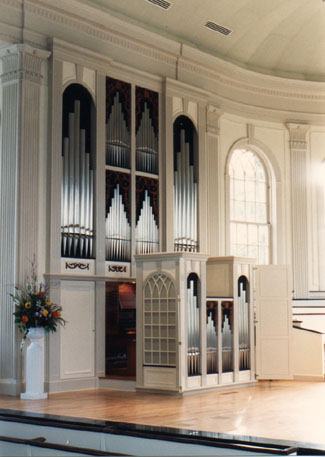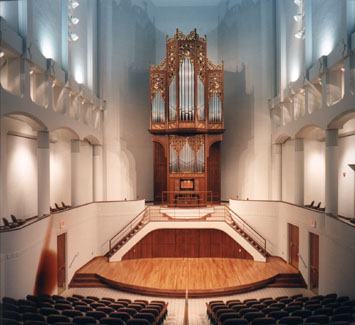Acoustical Society of America
136th Meeting Lay Language Papers
Three Organs, Three Recital Halls,
Three Acoustical Spaces
Three Acoustical Spaces
Hellmuth Wolff- HellmuthWolff@compuserve.com
Wolff & Associes Ltee
1260, Rue Tellier
Laval, QC H7C 2H2
Canada
Popular version of paper 4aAA4
Presented Thursday morning, October 15 ,1998
136th ASA Meeting, Norfolk, VA
(Note: Explanations of technical terms are in brackets.)
My presentation will actually consist of four organs built by Wolff and Associates and the four recital halls containing them will be discussed in an unscientific way. They are the following:
1) McGill University in Montreal: a French Classic organ for Redpath Hall

2) Knox College of the University of Toronto: a Swedish/North German Nordic type Baroque organ for the College Chapel

3) Kalamazoo College in Kalamazoo, Michigan: an eclectic organ for Stetson Hall

4) University of Kansas in Lawrence: a French Romantic organ for the Bales Recital Hall

I intended originally to talk about three organs, but I have decided to include also the organ at Knox College in Toronto. It is a historic type of organ and quite different from our other "historic" organ, the French Baroque organ at McGill University. Of course, a successful installation of an organ depends a lot on its acoustical environment. A French organ will sound out of place in a non-reverberant room, but a Nordic type, such as our organ at Knox College works well in the somewhat dry acoustics, such as those of the College chapel. Therefore I thought it might be interesting to discuss these two types of organs and their different acoustical environments.
1) Let us start with the McGill organ. Like most organ projects, it did not happen overnight; organists have been dreaming about an organ for Redpath Hall for several decades. However, one day their dream became true, when a benefactor spontaneously offered at a dinner party to do something about the lack of a concert hall organ at the music faculty. A good meal can do wonders!
Over a century ago, Redpath Hall was built as a reading room for the adjacent library. It always had a gallery which was used for the collection of rare books. With the building of a new library, Redpath Hall was no longer needed as a reading room and it was used only occasionally for concerts and banquets.
We have all heard musicians talk among themselves and may have thought that their ideas can sometimes be way up in the air. As builders, we often find that, when it comes to realizing a musical concept, such as a stoplist (the specifications of different stops of an organ), organists rarely have clear ideas about the spatial aspect of an organ. This is a good thing: they depend on us!
When McGill University asked us to build a French Classic organ, quite improbably there was sufficient space on the gallery, although it never had been intended for such a purpose. Our mandate was clear, since the French Classic organ is a very well defined type of an organ, not unlike French Baroque music itself, which follows precise recipes for the registrations. You just have to follow the recommendations of the 18th. Century Benedictine monk Dom Franois Bdos de Celles and you cannot go wrong. We took Dom Bdos' advice for the scalings of almost all the pipes as well as many other of his hints on layout and action design.
Architecturally, the French Baroque case does not seem to be in conflict with the English Guildhall style of Redpath Hall. I suspect that the many gargoyles of the beam structure must be for something, since the gargoyles were certainly inspired by those of French cathedrals. While the roof structure may have a bucolic aspect, the wooden roof with its tong and groove boards dampens the good influence of the heavy walls. In typical Victorian fashion, these walls with their pillars could have been taken right out of an Egyptian Temple. They are wonderful: they give the fonds de l'orgue (the fundamentals of the organ tone) a lot of warmth. One interesting bonus you will get in a hall with good bass frequencies is the cohesion of the low-pitched mutations, such as grosses quintes and grosses tierces with the fundamentals (an organ may have pipes sounding the fundamental tone as well as octaves, fifths and thirds - its harmonics - blending to make a single note).
On the other hand, mutations do not want to cooperate in halls with poor acoustics. You don't have the space for a tubby double open 16' (low-sounding large open wood pipes) and you would think you can compensate with resultants (harmonics that reinforce the fundamentals) : it does not work. In such a case, if the acoustician cannot make a miracle, the best thing to do is rebuild the hall or let someone else build the organ!
This was not the case at Redpath Hall and we are quite satisfied with its sound, even if we wished we had one or two more seconds reverb. Typically, the principals, or montres, (facade stops) are mild sounding stops, since they do not only form the base of the plenum (i.e. the full organ), but they also accompany the solo stops - 4' flutes were used rarely - so while the plenum is easy on the ears, it is the trumpets that make the noise and they are quite fiery, as they should be in the best French tradition. Once you have heard a trumpet piercing through the acoustical haze of a French cathedral, you will understand why fugues were played on the reeds and not on the plenum.
2) The Knox College organ was built in 1991, ten years after McGill. The college chapel was built in the early 1910s and the Casavant organ in the chancel dates from the same period. It is still used, especially for weddings, when a guest organist not familiar with tracker organs may be more at home. The presence of a romantic organ allowed us to build an organ along strict historical lines. The room was appraised by the acoustician Lesslie Dole as an ideal room for organ sound, but while it does not have real flaws and the sound travels quite well, we found it a bit on the dry side. As my colleague John Brombaugh commented on the hall in Appleton, Wisconsin, where he built an organ: it is disappointing to notice that the sound ends before the organist raises his hands after playing the last chord. This could have been a good reason for hiding the organist behind a Rckpositiv, but the Knox College organ had to have the layout of a Baroque organ. It is based on the work of the Swedish organbuilder Johan Niclas Cahman and the North German Berendt Huss for the Brustwerk. The exception is the pedal, which, for lack of space on the gallery had to be placed in two stories behind the main organ. The wooden resonators of the 16' Posaune (a trumpet stop which has funnels, the longest having 16' length, which amplify the vibrations made by a reed tongue) are placed on the sidewalls of the pedal. They rumble gloriously with their exceptionally wide shallots.
There was no gallery in this structure. It was a rather delicate task to integrate a new gallery in this very fine New-Gothic architecture. The lobby is a real jewel and could rival with the Victorian Earl Court in London.
A very steep and narrow spiral staircase could be built in the space between two arches, saving thus floor space and money. The gallery bottom is made in oak to be in line with the dark wood of the chapel. Like the casework, the railing is treated and painted in two shades of green. I mentioned the dark woodwork. Aside from being the culprit for the dry acoustics, the dark ceiling does not reflect light on the facade pipes. Such a ceiling always makes it hard to photograph the organ.
3) Let us move on quickly to the organ at Kalamazoo College. Since we do not have any acoustical illustrations, we may keep this chapter short, but I would like to mention the remarkable restoration of the college chapel and recital room, which William Garzelloni, the architects, and Lawrence Kirkegaard, the acoustician. made. The "acoustically transparent ceiling" (I hope they have found a better term since) was in 1988 used for the first time on a vaulted ceiling. It increases the volume of the space and reflectors can be hidden above the screen to allow the musicians to hear each other as well as to project the sound towards the audience. Much could be said about the complexities of an organ's placement in a chamber and how we dealt with these problems, but I think it would be more appropriate in a workshop for would be organ builders.
4) Bales Organ Recital Hall, University of Kansas
My chapter on the Bales Organ Recital Hall can again be brief since Robert Mahony will have preceded me with his comments on the same room.
Let me just say that I found the hall as perfect as any organ builder could wish for. You can hear the organ well from just about anywhere in the hall in the reverberant hall. However, it has its side effects and I said jokingly to James Higdon, one of the organ teachers, that we should have charged more for this organ, because voicing in such a reverberant room makes communication between the voicers so much more difficult than in an average room, where speech is favored over music. Judging the sound coming from the windchests in the cantilevered upper section of the case was also a bit frustrating, because, at the console, one is a bit in the shade, as the sound is going over one's head. This may, however, be a good thing for the students, since it may prepare them for the many other places where they cannot hear themselves play in balance. Think of the great Dutch organs, as in Leiden, Haarlem and Zwolle, for example!
Here we have an almost ideal situation, a wonderful resonant hall wrapped around the organ and the organbuilder is complaining! No, it is just that you have to put things in relative terms in front of other organ-hall experts but I must also say that it has been a once-in-a-lifetime experience to build for this magnificent recital hall and for the fine organ department of one of the major universities in North America.